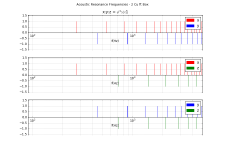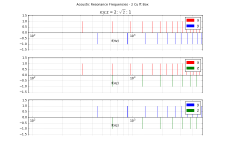Thanks for looking at it. I was looking at some online room node calculators to see what different shapes might bring. That wasn't easy to interpret, either.
All this chasing the golden ratio is kind of silly, even in rooms.
Go here:
Table of Contents for Art Ludwig's sound page
specifically note
Room acoustics
....shapes don't matter all that much. All rooms are horrible. Even spherical rooms have relatively similar nodes to rectangular ones. In a studio or listening room, nonparallel walls can reduce flutter echoes, but they don't move the modes much.
In a loudspeaker box, you should have damping material - damping material mostly makes this question of mode distribution and flutter echoes moot. Less of an effect than diffraction.
Thanks for the link Ron, but I would disagree that all rooms are horrible. I've owned and worked in a few that had smooth bass response but calculated has having distinct modes. I suppose that would scale into speaker box size.
Do agree about non-parallel walls and materials making a difference.
EDIT. I see what you mean about horrible, looking at Art's graphs. It's the same problem I had when looking at room mode calcs. They all look funk, and are difficult to interpret.
Do agree about non-parallel walls and materials making a difference.
EDIT. I see what you mean about horrible, looking at Art's graphs. It's the same problem I had when looking at room mode calcs. They all look funk, and are difficult to interpret.
Isn’t the goal to spread out the resonances to avoid pileups? Some quick math shows that:
The Golden Ratio: (0.618X1X1.618) yields a 2/3 octave spread between the first standing wave of each dimension.
A common acoustic ratio of: (0.7937X1X1.2559) spreads the first standing wave of each dimension by about 1/3 octave.
Like in a room, with every bounce / reflection, there is energy lost and at some point the reflections become statisticaly dense and small spaces by definition can’t develop reverb ie a statistically dense persistent homogenous sound field. With nearly any attempt to absorb some of the energy at each bounce, if the waves don’t pileup and reinforce themselves as in a cube, they will decay fairly rapidly.
Using a good ratio to start is low hanging fruit, so why wouldn’t we?
Until the space or box becomes acoustically large as compared to the lowest frequency of interest, the dimensions of an acoustical space largely determines the low frequency performance of the space.
On the other hand, if the enclosure of say a subwoofer is acoustically small in all dimensions as compared to the highest frequency of interest, the dimensions don’t matter.
That’s what years of measurments and some schooling have taught me anyway.
My best.
Barry.
The Golden Ratio: (0.618X1X1.618) yields a 2/3 octave spread between the first standing wave of each dimension.
A common acoustic ratio of: (0.7937X1X1.2559) spreads the first standing wave of each dimension by about 1/3 octave.
Like in a room, with every bounce / reflection, there is energy lost and at some point the reflections become statisticaly dense and small spaces by definition can’t develop reverb ie a statistically dense persistent homogenous sound field. With nearly any attempt to absorb some of the energy at each bounce, if the waves don’t pileup and reinforce themselves as in a cube, they will decay fairly rapidly.
Using a good ratio to start is low hanging fruit, so why wouldn’t we?
Until the space or box becomes acoustically large as compared to the lowest frequency of interest, the dimensions of an acoustical space largely determines the low frequency performance of the space.
On the other hand, if the enclosure of say a subwoofer is acoustically small in all dimensions as compared to the highest frequency of interest, the dimensions don’t matter.
That’s what years of measurments and some schooling have taught me anyway.
My best.
Barry.
If you brace the walls well and bring wall resonances up along with good stuffing to absorb at frequencies above the resonance that you have achieved, your main concerns would be standing waves inside the enclosure and then sound transmitted through the cone itself. Prime numbers would likely be just as good as the "Golden ratio" to address standing waves as it would minimize reinforcement of waves within the enclosure and as has been mentioned before, the length of the wavelength exceeding a dimension would not result in a standing wave.
wall resonances
Do note that we have not been talking about wall resonances, but internal cavity resonances. Wall resonances are largely caused by direct excitation by th ereactive energy of the driver working against its box fixings.
dave
In the majority of situations, you have a pair of resonant boxes reacting to a much larger resonant box. (The listening room) Usual out come is difficult to predict... so.. the best solution is to design the smaller box to be as resonate free as possible... as little as possible box radiation other than the drivers forward radiation assuming excellent box damping, especially in the 200 Hz-1,000 Hz spectrum. ... this seems easier with a sealed box alignment... with a system Q in the .85 to 1.0 design goal.
And as Dave points out, the panels in a speaker enclosure are excited by the vibrating mass of the diaphragm as much as by internal acoustic pressure.
Actually, not “as much by”, but way more than. Easily “illustrated if you like.
dave
Thank you for all the responses! I learned a lot from all of you.
And I contemplated more.
Humans simply cannot make dimensions true irrational numbers. If you round to 3 digits 1.618:1 becomes a rational number.
Many cabinet makers use 1.6 just for looks, but 5:8 is a minor sixth.
People can tune a violin or a guitar by ear because when the strings resonate with each other it suddenly sounds very different - we want the reverse to be true for the 3 dimensions of a box, that's all.
I am now thinking of choosing moderately large prime numbers as dimensions, and also using sloped sides as has been mentioned. Stuffing is essential as has been mentioned. However stuffing could only take care of standing waves, but not baffle diffraction.
Or maybe to pick irrational numbers that can only be approximated by moderately large primes. pi for example as 7:22 is excellent, there is no way those numbers can sound anything like real music. The golden ratio is less good, since as I mentioned after rounding 5:8 is a minor sixth.
Building a sub e.g. as a perfect cube wouldn't have mattered because the wavelengths are longer than the dimensions.
And I contemplated more.
Humans simply cannot make dimensions true irrational numbers. If you round to 3 digits 1.618:1 becomes a rational number.
Many cabinet makers use 1.6 just for looks, but 5:8 is a minor sixth.
People can tune a violin or a guitar by ear because when the strings resonate with each other it suddenly sounds very different - we want the reverse to be true for the 3 dimensions of a box, that's all.
I am now thinking of choosing moderately large prime numbers as dimensions, and also using sloped sides as has been mentioned. Stuffing is essential as has been mentioned. However stuffing could only take care of standing waves, but not baffle diffraction.
Or maybe to pick irrational numbers that can only be approximated by moderately large primes. pi for example as 7:22 is excellent, there is no way those numbers can sound anything like real music. The golden ratio is less good, since as I mentioned after rounding 5:8 is a minor sixth.
Building a sub e.g. as a perfect cube wouldn't have mattered because the wavelengths are longer than the dimensions.
Interesting! And as I mentioned in post # 11, two of the least boxy-sounding instrument amplifiers I've heard have enclosures that are not simple right rectangular prisms...they have two sloping walls, and, in fact, only one pair of walls are parallel (rather than the usual three pairs.)...at 1999 AES in NY, a guy with serious acoustic chops...said that something like 75% of room issues go away with a sloped ceiling…
I woke up in the middle of the night with an idea how to reveal graphically the problem of overlapping acoustic mode frequencies. Simply plot modes in, say, the x-direction above the x-axis, and modes in the y-direction below the x-axis. Your eye can then spot problem modes that are very close to (or right on top of) each other.
So this afternoon I spent an hour or so today modifying my program to make this type of plots. The two attached images show what I mean.
One is for a Golden Ratio box, the other for a box with square root of two edge ratios. You can immediately spot the problem modes in the square root of two box - red and green modes lining up vertically in the middle plot, i.e. every second z-axis mode falling right on top of an x-axis mode frequency.
Please note that these plots do not represent energy stored in a mode, or frequency response of an actual loudspeaker box. All they do is give us a snapshot of the problem frequencies that would occur in a rectangular prism loudspeaker box, based on a very simple math model that does not take into account many physical realities (such as energy absorption inside the box.)
In other words, some fun material for discussion, maybe a little food for thought, but nothing earth-shaking in any way whatsoever.
-Gnobuddy
Attachments
Do note that we have not been talking about wall resonances, but internal cavity resonances. Wall resonances are largely caused by direct excitation by th ereactive energy of the driver working against its box fixings.
dave
Hi Dave,
I understood that and perhaps should have elaborated more. The concern with internal resonances is the transmission of those resonances through the enclosure or driver. I guess I jumped ahead into how to minimize the transmission without directly addressing elimination of the resonances other than mentioning that the use of prime number ratios would likely be as effective as the Golden ratio. I have never seen any studies to suggest otherwise and frankly my own evaluations were based upon different cabinet ratios as measured through wall resonance measurements (I saw no difference. I went back to try to find my data but alas, I believe it may have been a casualty of a computer crash along the way).
Jay
- Status
- This old topic is closed. If you want to reopen this topic, contact a moderator using the "Report Post" button.
- Home
- Loudspeakers
- Multi-Way
- Golden Ratio

